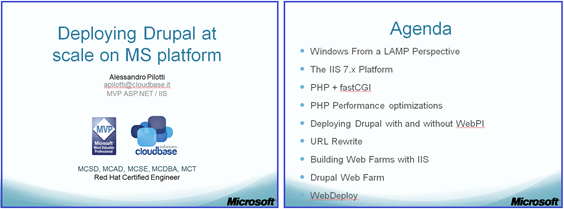Deploying Drupal at Scale on Microsoft Platform
I find that every conference I attend is a humbling experience. There are just so many knowledgeable people that I’m constantly reminded of how much I don’t know. The pre-conference training at DrupalCon Denver was no exception (and the real conference hadn’t even begun!). In the Deploying Drupal at Scale on Microsoft Platform training yesterday, Alessandro Pilotti delivered a densely packed training session that, once again, left me feeling humble. Alessandro’s breadth and depth of knowledge about running PHP applications on Windows (and Drupal in particular) is truly impressive.
As you can see from the training agenda, there is no way I can re-cap the day’s work in a single blog post, so I won’t try. I will, however, do my best to summarize his final demo of the day: creating a Drupal Web Farm using the Microsoft Web Farm Framework. What stood out at the end of the demo was the ease and speed with which he had a Drupal Web Farm up and running (almost completely from scratch!). Alessandro’s slides, which are attached to this post, go into much more detail than I will, so check them out if you want more than an interview.
Note: I will capture the high-level steps that Alessandro went through in creating a Drupal Web Farm. I’ve selected several slides from his presentation to to this – all of which show how to use IIS GUI tooling. However, Alessandro made a point of showing how everything he did could also be done from the command line using appcmd.exe and PowerShell commands.
Alessandro did a live demo of the following scenario: He had 4 Windows Server VM’s running on his laptop (480 GB SSD with 16 MB RAM !), which would serve as load balancer (Application Request Routing + Web Farm Framwork), two web servers (each hosting Drupal), and database server/file server.
Note: For the purposes of the demo, he used one VM for both the database server and file server, but he pointed out that having each on a separate machine (as shown in the diagram) would be the way to go for a production site.
Next, he used the Web Platform Installer to install Drupal and configure IIS on the primary server.
Again using the Web Platform Installer, he then installed Application Request Routing and Web Farm Framework.
With ARR and WFF installed, he could create a Web Farm…
…and add a primary host to the farm. (He also added the 2nd web server as a secondary host using the same UI.)
Finally, he provisioned the second server (and could have just as easily done more) using WFF. (Note that WFF uses Web Deploy. Complete details are in the attached slide deck.)
And, Voila! A scalable Drupal Web Farm. Of course, it wasn’t quite as simple as Voila!, but he did manage to go from four “blank” Windows Server VMs to a running web farm in about 45 minutes…very impressive IMHO.
Be sure to check out the attached slides from Alessandro’s presentation.
Thanks.
-Brian







